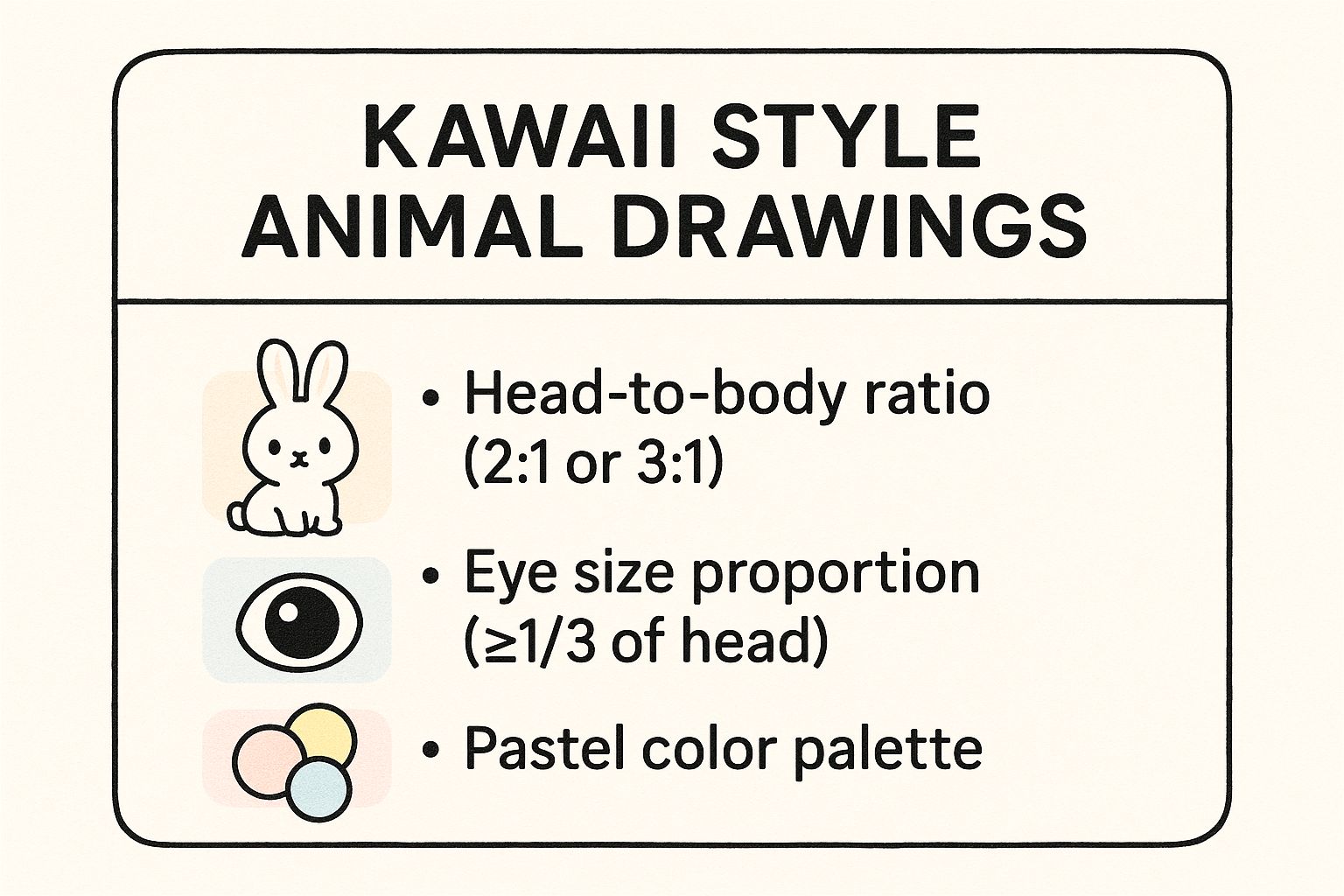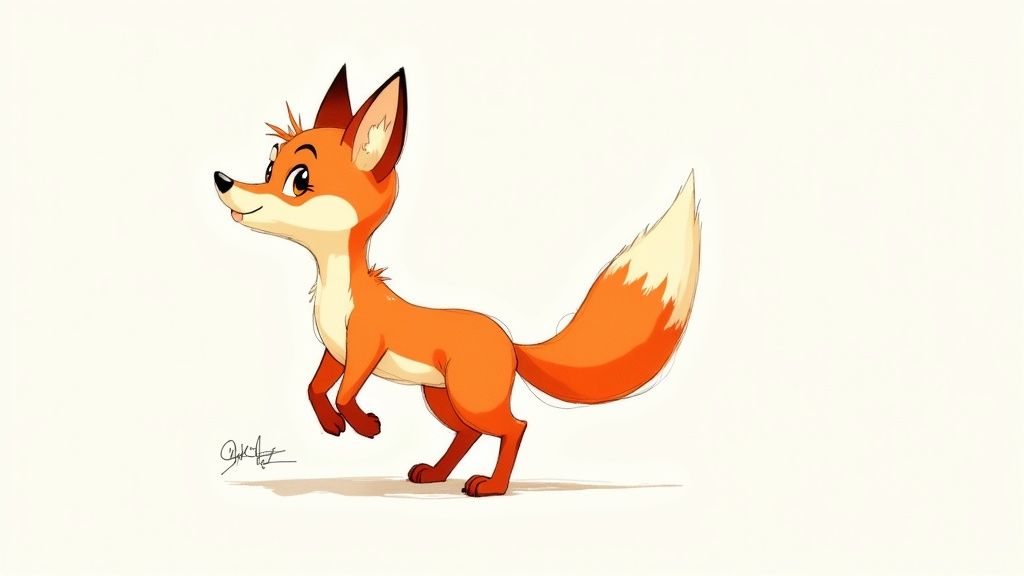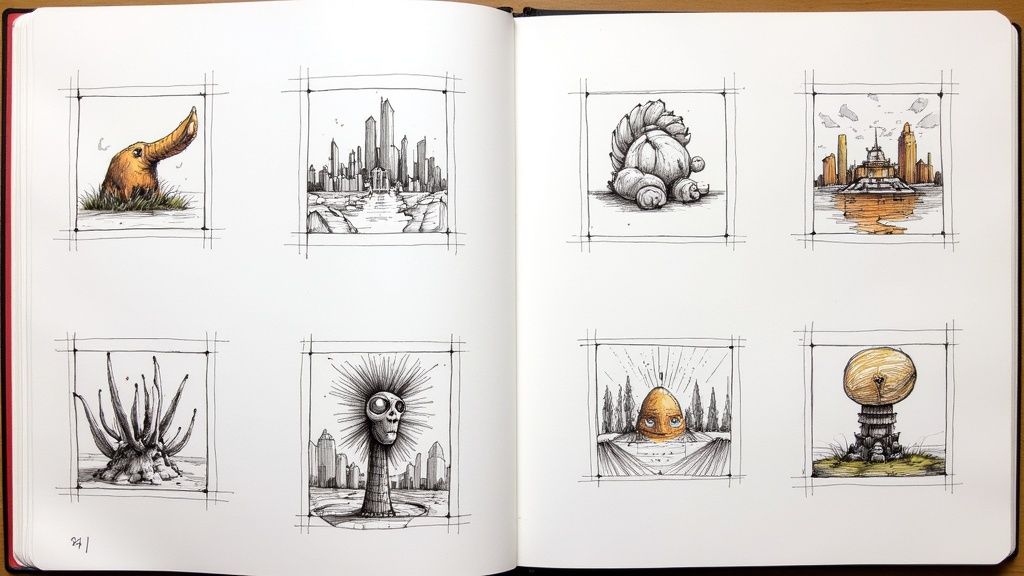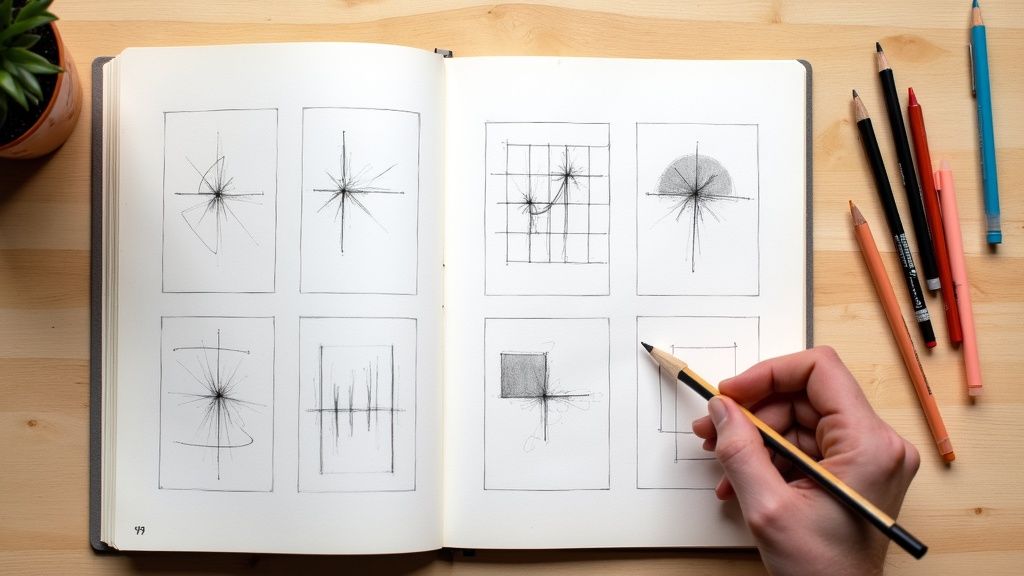Welcome, artists and animal lovers! If you're looking to fill your sketchbook with charming creatures, you've come to the right place. Cute animal drawings are more than just a fun pastime; they are a universal language of joy that resonates across cultures and artistic skill levels. From the simple, clean lines of minimalist art to the expressive, story-rich world of character art, each style offers a unique way to capture the delightful essence of the animal kingdom.
But where do you begin? How do you move beyond generic sketches and develop a style that's truly your own? This guide is designed to be your creative spark. We will explore eight distinct and popular styles for creating cute animal drawings, each with its own techniques and unique appeal. For every style, we'll break down the core features, provide actionable tips you can use today, and show you examples to get your imagination flowing.
Whether you're a seasoned illustrator seeking fresh inspiration or a beginner eager to learn, this curated roundup will provide the practical insights you need. Prepare to discover new techniques, refine your skills, and create the most endearing cute animal drawings you've ever made.
1. Kawaii Style Animal Drawings
The kawaii style, originating from Japan, is the art of extreme cuteness. It transforms ordinary subjects into irresistibly adorable characters by emphasizing specific features that trigger a sense of affection and care. This approach is perfect for artists looking to create heartwarming and universally appealing cute animal drawings.
The core principle of kawaii is simplification and exaggeration. Think of iconic characters like Sanrio's Hello Kitty or the lovable Pokémon. They all share common traits: oversized heads, large and expressive eyes, and simplified bodies. Details are minimal, focusing the viewer's attention on the features that convey emotion and innocence. This style intentionally moves away from realism to create a world of soft, gentle, and charming creatures.
How to Create Kawaii Animals
Getting started with kawaii is straightforward because it’s built on simple foundations. You don't need to be an expert in anatomy; instead, focus on proportions and linework.
- Start with Basic Shapes: Use circles, ovals, and rounded rectangles as the building blocks for the head and body.
- Emphasize the Eyes: Make the eyes disproportionately large, taking up at least one-third of the head's vertical space. Keep them simple, often just black circles with one or two white highlights to suggest shininess.
- Use Curved Lines: Avoid sharp angles and straight lines. Soft, curved lines contribute to a gentle and approachable look.
- Add Subtle Details: A tiny, simplified mouth (or no mouth at all), and small pink or red ovals on the cheeks for blush marks are classic kawaii elements that amplify the cuteness factor.
This quick reference infographic summarizes the essential proportional and color guidelines for achieving the signature kawaii look.

Mastering these core principles of head-to-body ratio, eye size, and color choice is fundamental to capturing the style's unique charm. For those eager to explore this aesthetic further, you can find a wealth of inspiration and tutorials. Learn more about the specific techniques and history of cute kawaii drawings on drawinglist.com.
2. Disney-Style Animal Character Art
Disney's approach to cute animal drawings is iconic, blending realistic animal anatomy with expressive, human-like characteristics. This style is less about simple cuteness and more about creating compelling characters with personality and emotional depth. It uses anthropomorphism to tell stories, making animals relatable and memorable through their carefully crafted features and dynamic expressions.

The magic of this style, seen in classics like Bambi and modern hits like Zootopia, comes from its foundation in animation principles. Pioneered by legends like Walt Disney and Glen Keane, this method focuses on movement, emotion, and storytelling. Unlike the static simplicity of kawaii, Disney-style art captures life and motion, giving each character a believable inner world that resonates with audiences.
How to Create Disney-Style Animals
To master this style, artists must balance animal accuracy with artistic exaggeration. The goal is to build a character that feels both authentic to its species and capable of a wide range of human emotions.
- Study Real Anatomy First: Before you can exaggerate, you must understand the real thing. Study the bone and muscle structure of the animal you are drawing to create a believable foundation.
- Focus on the 'Line of Action': This is an imaginary line that runs through a character's pose, indicating their movement and energy. A strong, curved line of action makes a drawing feel dynamic rather than stiff.
- Use 'Squash and Stretch': This core animation principle adds flexibility and life to your drawings. A character can "squash" down in anticipation and "stretch" out during an action, exaggerating movement and impact.
- Master Emotional Expressions: Pay close attention to how eyebrows, eyelids, and mouth shapes convey feelings. Small changes in an eyebrow's arch can transform a character's expression from happy to surprised or sad.
3. Chibi Animal Art
Chibi, a Japanese slang term meaning "short" or "small," is an art style defined by its "super-deformed" proportions. It dramatically shrinks a character's body while enlarging its head, resulting in an irresistibly cute, toddler-like figure. This style is a fantastic method for creating cute animal drawings that are packed with personality and charm.
The essence of chibi art lies in its playful exaggeration. Unlike more proportional styles, chibi focuses on creating a concentrated dose of adorable by simplifying complex anatomy into soft, rounded forms. Think of the charming villagers in Nintendo's Animal Crossing or the collectible Nendoroid figures from Good Smile Company. These examples master the chibi aesthetic by balancing minimalist detail with maximum emotional appeal, making the characters feel both lovable and iconic.
How to Create Chibi Animals
Drawing in the chibi style is accessible even for beginners because it relies on a clear set of proportional rules rather than anatomical accuracy. The key is to embrace the "small and chubby" philosophy.
- Focus on Head-to-Body Ratio: The most crucial element is the oversized head. Aim for a head-to-body ratio of approximately 2:1 or 3:1, where the head takes up half or more of the character's total height.
- Keep Limbs Short and Stubby: Arms and legs should be short, simple, and chubby. Avoid defining joints like elbows or knees; instead, use simple sausage-like shapes to maintain a soft appearance.
- Add Expressive, Shiny Eyes: Just like in kawaii, large eyes are essential. Give them extra sparkle with prominent white highlights to create a glossy, "wet" look that adds life and innocence to your character.
- Simplify the Details: Keep the overall design clean. A simple background or no background at all will help your chibi animal stand out. Focus on a single, clear expression or pose, such as a simple sitting or waving gesture.
This approach is perfect when you want to create art that is instantly endearing and full of character. To see how professional artists apply these principles to create commissioned pet portraits and merchandise, explore the wide variety of chibi animal art on Etsy, where you can find endless inspiration.
4. Realistic Cute Animal Portraits
Realistic cute animal portraits capture the inherent charm of animals by focusing on anatomical accuracy and lifelike detail. This style moves beyond caricature to celebrate the natural cuteness found in young animals, such as puppies, kittens, or wildlife cubs. Artists emphasize soft fur textures, soulful eyes, and authentic expressions to create deeply emotive and engaging cute animal drawings.
The goal is to produce a portrait that feels both true to life and irresistibly adorable. Unlike stylized approaches, this method relies on keen observation and technical skill to render realistic proportions, lighting, and textures. The cuteness is not exaggerated but highlighted through the careful selection of poses, compositions, and moments that showcase an animal's natural innocence and appeal. This style is often seen in pet portrait commissions and wildlife art inspired by photography.

How to Create Realistic Animal Portraits
Achieving realism requires patience and a good eye for detail. The process involves building up layers of tone and texture to create a sense of depth and form. This approach is ideal for artists who enjoy a more methodical and detailed drawing process.
- Use High-Quality Reference Photos: A clear, well-lit photograph is crucial. It provides all the information you need about fur direction, highlights, and shadows.
- Start with Basic Shapes: Lightly sketch the fundamental shapes of the head, body, and limbs to establish accurate proportions before adding any detail.
- Pay Special Attention to the Eyes: The eyes are the focal point. Capture the reflections, or "catchlights," to make them look wet and alive. This single detail can bring the entire portrait to life.
- Study Fur Growth Patterns: Draw fur in the direction it naturally grows. Use varied strokes-short, long, soft, and sharp-to build up realistic texture rather than drawing individual hairs.
- Use Blending Techniques: Employ tools like blending stumps, tortillons, or even cotton swabs to create smooth gradients and soft transitions, which are essential for rendering soft fur and features.
Mastering these techniques allows you to create stunning portraits that are both technically impressive and emotionally resonant. For those looking to dive deeper into this beautiful art form, you can find more guidance and inspiration. Learn more about the specific methods for creating realistic cute animal portraits on drawinglist.com.
5. Cartoon Animal Illustrations
Cartoon-style art is a classic and highly effective way to create cute animal drawings that are both charming and full of personality. This approach uses simplified shapes, bold outlines, and exaggerated features to craft friendly, approachable characters. Unlike realism, cartooning prioritizes clear visual communication, personality, and often humor, making animals appear distinctly non-threatening and full of life.
The core of cartoon illustration lies in its expressive power. Think of the grumpy charm of Garfield or the zany energy of characters from classic Warner Bros. or Cartoon Network shows. These designs are memorable because they distill an animal's essence into a few key, exaggerated traits. This style is incredibly versatile, fitting perfectly into comic strips, children's books, and educational materials where immediate appeal and clarity are paramount.
How to Create Cartoon Animals
Drawing in a cartoon style is about finding a balance between simplification and exaggeration. You don't need perfect anatomy; instead, you focus on what makes the character feel alive and engaging.
- Use Consistent Line Weights: Start with a clean, consistent outline for your character. This bold linework helps the subject stand out and gives it a solid, defined look that is easy to read.
- Exaggerate Key Features: Identify one or two distinctive features of the animal, like a cat's ears, a rabbit's teeth, or a bird's tail, and make them disproportionately large or small. This exaggeration is a key source of the character's appeal and personality.
- Limit Your Color Palette: Stick to a simple palette of three to five main colors. This keeps the design clean, cohesive, and visually impactful without overwhelming the viewer.
- Keep Backgrounds Simple: Ensure your character is the star. Use minimal or nonexistent backgrounds to keep the focus squarely on your cute animal drawing and its expressive actions or emotions.
- Test for Readability: Good cartoons are easily recognizable even at a small size. Shrink your drawing down to see if its primary features and silhouette remain clear and distinct.
This approach, popularized by legendary artists like Jim Davis and Chuck Jones, remains a fundamental skill for anyone interested in character design. To dive deeper into this expressive art form, you can find a variety of inspiring prompts and guides. Learn more about the endless possibilities with cartoon drawing ideas on drawinglist.com.
6. Watercolor Animal Sketches
Watercolor techniques create soft, dreamy cute animal drawings with flowing colors and gentle transitions. The medium’s natural unpredictability adds a unique, organic charm to animal illustrations. This approach is ideal for artists wanting to capture a gentle, whimsical, and heartwarming feel in their work.
The beauty of watercolor lies in its transparency and fluidity, which perfectly complements the soft nature of cute animal subjects. Think of the timeless illustrations by Beatrix Potter for her Peter Rabbit series; their soft edges and delicate color washes evoke a sense of nostalgia and tenderness. This style moves away from sharp, defined lines to create a world filled with gentle light and airy atmospheres, making animals appear both lifelike and enchanting.
How to Create Watercolor Animal Sketches
Getting started with watercolors requires a bit of patience, as the medium behaves differently than pencils or digital tools. The key is to embrace its fluid nature and build color in layers.
- Use Proper Paper: Always use watercolor paper, ideally 140 lb (300 gsm) or heavier, to prevent the paper from buckling when wet.
- Work Light to Dark: Begin with the lightest colors and gradually build up to darker tones. It's much easier to add pigment than it is to lift it away.
- Let Layers Dry: Allow each layer of paint to dry completely before adding another. This prevents colors from becoming muddy and creates crisp, clean transitions where needed.
- Embrace "Happy Accidents": Watercolors can be unpredictable. Instead of fighting unexpected blooms or blends, learn to incorporate them into your drawing for a unique, organic effect.
- Keep a Spray Bottle Handy: A small spray bottle of clean water can help you re-wet areas of your painting to soften edges or blend colors smoothly.
This technique is especially effective for subjects like fluffy bunnies, delicate birds, or sleepy foxes, where soft textures and gentle expressions are paramount. The resulting artwork often has a storybook quality, making it popular for greeting cards, custom pet portraits, and children's book illustrations.
7. Minimalist Line Art Animals
Minimalist line art distills an animal down to its most fundamental form, using clean, often continuous, lines to create an elegant and modern image. This contemporary style excels at capturing the essence of an animal's shape and personality with incredible simplicity, making it a sophisticated choice for creating cute animal drawings that feel both artistic and refined.
The power of this style lies in its use of negative space and suggestion. Unlike detailed illustrations, minimalist line art invites the viewer's mind to fill in the gaps, creating a more engaging and personal experience. It proves that cuteness doesn’t always require big eyes or chubby cheeks; sometimes, the graceful curve of a cat's back or the simple outline of a rabbit's ears is all that's needed to convey charm and character. This approach is popular in modern home decor, tattoos, and branding.
How to Create Minimalist Line Art Animals
Embracing minimalism is about focusing on what is essential. This style challenges you to communicate the most with the fewest possible marks, a skill that enhances your understanding of form and movement.
- Practice Continuous Lines: Try drawing an animal without lifting your pen from the paper. This exercise forces you to identify the most crucial contours and simplifies the form naturally.
- Study Key Shapes: Before drawing, observe the animal and break it down into basic geometric shapes. Focus on capturing these core forms rather than small, intricate details.
- Isolate Characteristic Features: Identify the one or two features that make an animal instantly recognizable, like a fox's bushy tail or an elephant's trunk, and make them the focal point.
- Vary Line Weight: Use a slightly thicker line for foundational shapes and a thinner line for subtler details. This simple technique adds depth and visual interest without clutter.
- Embrace Imperfection: The slight wobbles or breaks in a line can add a natural, hand-drawn charm that makes the artwork feel more authentic and approachable.
8. Digital Cute Animal Art
Digital platforms have revolutionized how artists create cute animal drawings, offering a powerful medium with unlimited colors, easy corrections, and special effects impossible with traditional media. This approach combines the best of all styles, allowing artists to experiment with various techniques, from crisp vector graphics to soft painted effects, all while maintaining the precision and flexibility that digital tools provide. Think of vibrant mobile game characters or stylized Instagram animal portraits; these are often born from digital software.
The core advantage of digital art is its forgiving and versatile nature. An artist can undo a stray line with a single click, layer colors to create depth without muddying pigments, and resize elements to perfect proportions. Software like Procreate and Adobe Creative Suite has made digital drawing more accessible than ever, popularizing a clean, polished aesthetic. This makes it an ideal choice for creating everything from custom pet portraits and YouTube mascots to unique NFT art collections.
How to Create Digital Cute Animals
Transitioning to or starting with digital art involves learning your tools, but the creative principles remain the same. The focus is on leveraging the software's capabilities to enhance the cuteness.
- Invest Time in Your Software: Spend time learning the features of your chosen program, whether it's Procreate, Adobe Illustrator, or Clip Studio Paint. Understanding layers, masks, and blending modes is crucial.
- Use High-Resolution Canvases: Start with a large canvas size (e.g., 3000x3000 pixels at 300 DPI) to ensure your final artwork is sharp and suitable for printing or high-quality display.
- Experiment with Brushes: Digital art offers an endless library of brushes. Try different textures, from smooth ink pens for clean lines to watercolor or gouache brushes for a more traditional look.
- Create Custom Color Palettes: Develop unique color palettes to give your animal drawings a consistent and signature style. Save them within your software for easy access.
- Save Frequently: Get into the habit of saving your work often and using version control. This prevents losing progress and allows you to revisit earlier ideas if needed.
Cute Animal Drawing Styles Comparison
Style | Implementation Complexity | Resource Requirements | Expected Outcomes | Ideal Use Cases | Key Advantages |
|---|---|---|---|---|---|
Kawaii Style Animal Drawings | Beginner-friendly | Basic drawing tools, pastel colors | Cute, simple, emotionally evocative characters | Merchandise, beginner art, casual design | Easy to learn, universally appealing |
Disney-Style Animal Character Art | Intermediate to Advanced | High skill, time investment | Emotionally expressive, dynamic characters | Storytelling, animation, complex character work | Strong emotional connection, versatile |
Chibi Animal Art | Beginner to Intermediate | Digital or traditional art supplies | Super-deformed, highly cute and shareable characters | Stickers, social media, anime/manga art | Quick to draw, highly shareable |
Realistic Cute Animal Portraits | Advanced | High-quality materials, extensive practice | Lifelike, detailed, anatomically accurate portraits | Fine art, pet portraits, galleries | Demonstrates skill, lasting emotional impact |
Cartoon Animal Illustrations | Beginner to Intermediate | Basic drawing tools | Bold, exaggerated, humorous characters | Children's books, comics, educational materials | Easy reproduction, highly recognizable |
Watercolor Animal Sketches | Beginner to Intermediate | Watercolor paints, paper | Soft, flowing, organic-looking illustrations | Greeting cards, pet portraits, children’s books | Unique effects, soft aesthetic |
Minimalist Line Art Animals | Intermediate | Minimal supplies, good form knowledge | Elegant, simple, modern animal representations | Logos, tattoos, modern decor | Sophisticated, quick once mastered |
Digital Cute Animal Art | Intermediate to Advanced | Software, digital hardware | Versatile, editable, high-quality digital art | Online content, games, animations, NFTs | Undo/redo, multiple styles, easy sharing |
From Blank Page to Adorable Creations
We've journeyed through a vibrant and diverse zoo of artistic possibilities, exploring a wide range of techniques to bring your own cute animal drawings to life. From the iconic, rounded forms of Kawaii and Chibi styles to the emotive, character-driven world of Disney-inspired art, each method offers a unique pathway to charm and personality. We’ve seen how realistic portraits can capture a touching sense of soulfulness and how bold, simple cartoon illustrations can convey immense joy.
The journey doesn't stop here; it's a launchpad for your own creative exploration. The most powerful takeaway is that these styles are not rigid rules but flexible frameworks. The magic happens when you begin to blend them. Imagine combining the elegant flow of watercolor with the exaggerated proportions of a Chibi puppy, or applying the crisp, clean finish of digital art to a minimalist line drawing of a cat. This fusion is where your unique artistic voice will truly begin to shine.
Your Path Forward: From Inspiration to Action
Mastering the art of cute animal drawings is about more than just technical skill; it's about learning to see the world through a lens of whimsy and wonder. It's about capturing the essence of what makes an animal endearing, whether it's the playful tilt of a head, the oversized, curious eyes, or the simple comfort of a curled-up sleeping form. The value in practicing these different approaches is building a versatile creative toolkit.
To put these ideas into practice, follow these actionable steps:
- Select One Style to Master First: Choose the style from our list that excites you the most. Dedicate a week to drawing various animals exclusively in that style to build confidence and understanding.
- Create a "Style-Mashup" Project: Pick two distinct styles, such as Realistic and Cartoon. Your challenge is to draw the same animal, like a red panda, by blending key elements from both. This is an excellent exercise for pushing creative boundaries.
- Build a Reference Library: For every style you practice, save 5-10 images from other artists that you find particularly inspiring. Analyze what makes them effective. Is it the line weight? The color palette? The composition?
Ultimately, the goal is to transform the spark of an idea into a finished piece you can be proud of. The most significant barrier is often not a lack of skill but the simple act of starting. Overcoming that initial hesitation is the key to unlocking a world of adorable creations. Every drawing, regardless of the outcome, is a valuable step on your artistic journey. So, pick up your pen, pencil, or stylus, choose an animal that makes you smile, and let your imagination run wild.
Ready to banish artist's block for good? For a limitless stream of creative prompts specifically tailored to animals, characters, and scenes, explore the idea generators at Drawing List. Visit Drawing List to find the perfect prompt that will get you creating your next cute animal masterpiece today.


